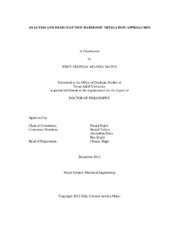| dc.description.abstract | Numerous approaches have been proposed in order to resolve the problems of current harmonics in electrical distribution systems. The rapid development of power semiconductors along with the revolutionary advances on microprocessors consolidated the motor drives industry and with it a massive proliferation of non-linear loads. It was thought that these very same technological advances would trigger an explosive development of harmonic solutions based on power electronics. Moreover, the introduction of the instantaneous active and reactive power theory or the so-called p, q theory which simplifies and gives more robustness to the control strategies of active filters reinforced this idea. Three decades have passed since the first IGBT was introduced in early 1980s, and active harmonic solutions are not the first choice to solve harmonic pollution in electrical distribution systems, mainly due to the high cost and the perception of low reliability. Given this scenario, in this work two main approaches are explored. First, the combination of an asymmetric 18-pulse rectifier with a reduced KVA active harmonic filter to improve the performance under abnormal utility conditions. Second, an interleaved active harmonic filter using multiple inverters connected in parallel at the ac and dc size, which will allow for higher power ratings and power density increase.
The performance issues of the asymmetric 18-pulse rectifier under unbalanced voltage and pre-existing harmonic components are analyzed, as well as the current distortion improvement, achieved when an active power filter is introduced.
On the other hand, the high frequency harmonic cancellation when interleaved inverters are used, the circulation of zero-sequence current and the impact of interleaving on dc bus capacitor are analyzed. Finally, some methods to mitigate the low frequency circulating currents based on eliminating the zero-sequence component, and the introduction of common mode inductors to reduce the high frequency circulating current are studied.
Without a doubt the search for new cost-effective topologies able to reach broader power levels and voltage ranges will continue emerging giving more alternatives to users. Moreover, extensive research on wide band gap devices such as Silicon Carbide (SiC) and Gallium Nitride (GaN), with which it is possible to reach higher voltage breakdown and at least an order-of-magnitude lower switching losses, makes the future more promising for active solutions. | en |


